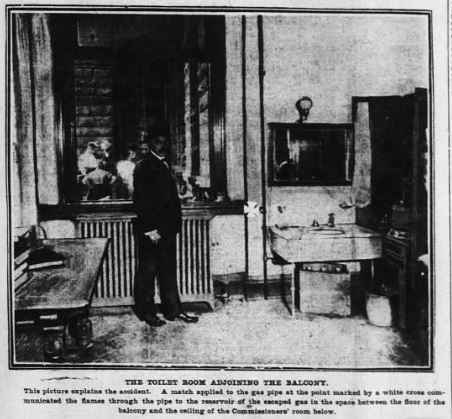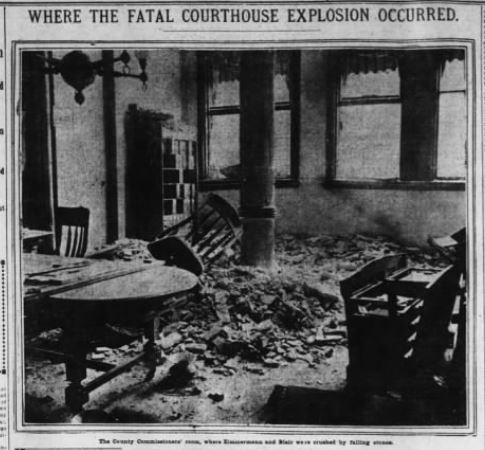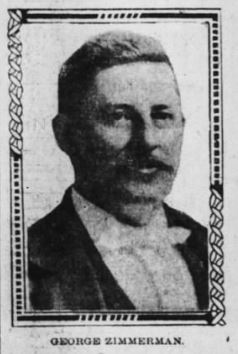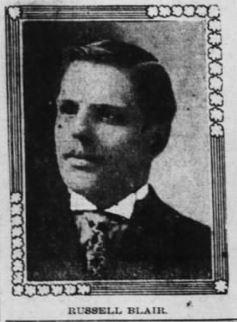The Explosion
On October 4, 1905, an explosion shook the Hamilton County Courthouse. For years, county workers had complained about the smell of gas in the building and had been trying to find the source of the leak. They went so far as to tear up the floors and the walls where the smell was the strongest. At about 3 o’clock, on the afternoon in question, the County Clerk called for the Superintendent of Buildings and asked that he try to solve the problem before the weather got too cold. The Clerk was concerned that if they had to close the windows the smell would be so strong they wouldn’t be able to work in the room.

After a few minutes examining the room the Superintendent declared that he couldn’t smell any gas. I wonder if in retrospect, this could have been the cause of the problem. The man trying to find the leak, was the only one who didn’t smell it. In a flash of ingenuity our olfactorally challenged Superintendent decide to light a match and run it along the length of the gas pipe.
The explosion came without warning.
An exceedingly incorrect statement printed by The Cincinnati Enquirer 05 Oct 1905
His hypothesis was that the leak would be blowing gas out of the pipe and the match would flame up for a moment if he encountered it. Instead, he watched in horror as the small flame shot into the pipe. No longer in view, it traveled through pipe, below the heavy stone floor, and a second later an explosion was heard, which “sounded like the roar of a dozen cannons” (Cincinnati Enquirer, 1905). The heavy stone balcony outside the window rose slightly and then collapsed.
The balcony formed the roof of one of part of the Commissioners’ office below. The explosion hit less resistance on it’s way down, through the plaster ceiling, than it had up against the stone. There were four men in the room below. A man named George Kleeman was standing against one wall using the telephone. D.K. Kellar was standing against the opposite wall. Both escaped fatal injury. George Zimmerman, County Commissioners’ Clerk, and Russell Blair, his assistant, were sitting at their respective desks in the center of the room and received both the force of the explosion and the force of the debris.
Men from the building swarmed the office, knowing that Zimmerman and Blair were at their desks, hoping to rescue them. The dust and smoke was too thick to see through. It wasn’t until a substantial portion blew out the busted window that the scene became clear. The desk was crushed under a slab of stone that was four feet square. The chairs the men were sitting in had been “crushed to the floor like egg shells”. A mass of dirt, plaster, and stone had buried the men under two feet of debris and only their feet were visible. Men began digging at the debris with their hands to free the bodies.

Russell Blair was found dead under the debris. It is reported that in hopes some spark of life may have remained he was taken to the hospital before eventually being taken to the morgue. His skull was described as crushed, and given medical science at the time, I have to imagine that those involved knew that it would be a fruitless endeavor. George Zimmerman was still alive when he was removed from the rubble. He was rushed to the hospital but died en route.
The Superintendent was said to be beside himself following the explosion, having been friends with the men who were killed. He frantically issued orders, including that the gas be shut off to the building. The job had already been done by the Chief Engineer.
“I did it. I’ll tell you just how it was.”
The Superintendent speaking to an Enquirer reporter as printed 05 Oct 1905
His face was ghastly white, his voice broken and lips twitching.
“I was trying to find that old leak, and lit a match and held it close to the gas pipe; then the explosion came. The flame followed the gas into the wall, and it exploded immediately. My God, this is awful.”
The Aftermath
An inspection of the building showed that the gas pipe that ran under the stone balcony had corroded and rusted. Gas had accumulated in a space between the balcony floor and the ceiling below. In the explosion, the iron girders that held up the stone floor were twisted and it was feared that there would be further collapse due to instability. The paper says that this is the reason the public was not allowed in the area. That’s a good reason, but it does seem unnecessary. Even if it looked perfectly stable, probably not a good place for people to wander about.
The victims were attended to at the city morgue where it was found that both had broken necks. George Zimmerman had a large hole in the right side of his face, which exposed his teeth. Russell Blair’s head was crushed and it was believed he was killed instantly. Both men received visitors in the morgue, which I don’t think is something you can do anymore. The bodies were then sent to the undertaker’s to be prepared for burial. They were then sent to their respective homes, which was the custom before funeral homes became a thing.
After the incident two separate brother-in-laws of George Zimmerman came forward to claim it was a miracle that they weren’t also killed. John Schneider had been passing in a streetcar and had waved to George. He was about to hop off and go in to say hello when something told him to stay on the car. He listened to the little voice and therefore was not in the office chatting with George at the time of the incident. Personally, I’m not much of a believer in little voices of fate as no one recognizes when they come around And nothing tragic happens. They only seem to notice them after a tragedy has been obviously averted. It all seems very opportunistic if you ask me.
The second brother-in-law was standing in a bowling alley (at three in the afternoon on a work day) when a fifty pound ceiling fan fell to the ground next to him. It scraped his body and it was supposed that if it had hit him straight on, it would have killed him. Either way, he should have probably kept this story to himself as his sister was in the process of grieving her actually dead husband.
Non-relatives also got in on the action. A real estate broker who had a meeting with Russell Blair came forward to make it clear that he miraculously escaped death. He had a meeting scheduled with Blair from 2:30 to 4:00, but he had decided not to go when he remembered another matter that required his attention. So not only is he a person who comes forward to attention grab after tragedy, he’s also a person that skips appointments willy nilly.
It’s possible I have a greater than average aversion to the people who wax poetic about “could have been me” after tragedies.
The Victims

George Zimmerman, 45 years old, had worked in the County Commissioners office as a clerk for 13 years before the accident. When he was young he had studied telegraphy but had decided that office work would be the more lucrative career. He was well known and popular. An easy-going and quiet man who was able to accomplish difficult tasks with little energy. He lived with his wife, Anna, at 3233 Vine street. His wife, had been at the Grand Opera House at the time of the explosion. Already in poor health it was feared that the shock would affect her greatly. George was buried in the Vine Street Hill Cemetery. Anna lived another 50 years.

Russell Blair was a 27 year old who lived with his parents in Montgomery, Ohio. He was due to be married to Miss Ruth Buckingham thirteen days after the explosion. He had recently received his law degree and passed the bar, intending to make his living as a lawyer. In preparation for his marriage he’d bought a new house and “paid the last installment…and received the deed last week.” I had to read that sentence a few times before I really grasped it. He paid for a house, in full, before ever moving in. Personally, I enjoy avocados too much to have that kind of money.
Russell was buried in Hopewell Cemetery in Montgomery, Ohio.
George Kleeman, who you should remember him from earlier. He was using the phone at the time of incident. He wasn’t killed, but he was injured. He had been reluctant to go to the hospital, unsure if his injuries warranted it. He was covered in blood, dust, and debris and was eventually convinced. When he arrived they cut his hair close to the scalp to better see his injuries and found that he had seven distinct scalp wounds. He also had two broken fingers on his left hand, the result of throwing his hand above his head at the noise of the explosion. Here is his memory of the incident:
All seems a hideous dream. When I was at the telephone I suddenly heard a loud report like the detonation of many cannon. I fell to the floor, my eyes and ears filled with dust and then I groped about blindly. I was dazed but still had the presence of mind enough to try to shield my head and to seek an exit. Once bef0re, I had a similar experience. It was in the Robinson Opera House disaster seven years ago when my poor wife was killed…
Suddenly I felt some one grasp my hand. I do not know who it was, but he soon let go and then I made another supreme effort. My foot struck the railing that divides the office and I knew I was on the road to safety. I found the door, got into the corridor and then I fainted.”
George Kleeman via the Cincinnati Enquirer 05 Oct 1905
Please rest assured that I will find out everything there is to know about what happened at the Robinson Opera house in 1898. George died of a heart attack in 1933 at 63 years old.
The Lesson
Our main takeaway from this tale is that if you’re looking for a gas leak don’t try to find it with a match.
Story sourced from the Cincinnati Enquirer and various genealogy records. If you’re interested in the history of your family please go to the contacts page and fill out the card. You can find your answers right here in a few weeks.